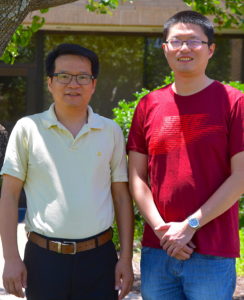AgriLife scientists uncover a new face of a famous protein, SWI2/SNF2 ATPase
Research can aid human cancer treatment, plant and animal agriculture
Media contact: Blair Fannin, 979-845-2259, [email protected]
Contact: Dr. Xiuren Zhang, 979-458-0596, [email protected]
COLLEGE STATION – A team of Texas A&M and Texas A&M AgriLife Research scientists now have a deeper understanding of a large switch/sucrose non-fermentable (SWI/SNF) protein complex that plays a pivotal role in plant and human gene expression that causes life-threatening diseases such as cancer.
Their findings could lead to more targeted therapies and help with physiological improvements in both crops and animal agriculture. The work may provide a new idea to manipulate the functions of this protein for a better therapeutic strategy for curing human cancers.
Drs. Xiuren Zhang and Dr. Zhiye Wang, along with a team of scientists in the department of biochemistry and biophysics and Institute for Plant Genomics and Biotechnology at Texas A&M University in College Station

have had their findings published online as a full article in the journal, Nature, https://www.nature.com/articles/s41586-018-0135-x.

The team has been working for years on how microRNAs are produced in the model plant Arabidopsis. MicroRNAs are tiny regulatory RNA molecules widely present in multicellular organisms. In humans, microRNAs inhibit more than 60 percent of human genes and are actively exploited as potent drugs to cure human diseases, according to the scientists.
In plants, the molecules can also control many aspects of life such as plant architecture, and responses to hostile environmental conditions. MicroRNAs are also widely engineered in agricultural crops and animals for better yield and quality.
MicroRNAs are produced in a factory inside cells from long substrates that can be hundreds or thousands of bases and also contain a distinct hairpin-structure. The factory contains a scissor-like enzyme called Dicer, and some assistants that help to fetch the long substrates. One of the assistants is known as Serrate protein, Zhang said.
“Also, the shape of the substrates is very critical for microRNA production,” Zhang said. “If the shapes are changed, then the substrates do not fit the Dicer scissor and can not be cut, and microRNAs are not made.”
“We are interested in finding whether there are other workers in the factory,” Wang said. “We used Serrate protein as a fishing bait to catch the prey; and we caught chromatin-remodeling factor 2 (CHR2).”
CHR2 is a SWI2/SNF2 motor protein with ATPase activity, Wang said.
“It also has a nickname Braham, after a creator God in Hinduism that has four heads and multiple arms, representing brilliancy and power,” he said.
Wang said CHR2 is essential for producing RNA from DNA templates because its ATPase activity breaks down ATP to generate energy.
“It loosens chromatin where DNA is packed so that RNA-producing enzymes can now access the DNA templates to make RNAs including the long substrates for microRNAs,” Wang said. “This is really surprising. We asked, why does CHR2 leave its own home in the chromatin and elope with Serrate into the microRNA producing factory?”
Using the plants that lack CHR2 gene, they found that the long substrates of microRNAs are reduced.
“This totally makes sense because the chromatin cannot be opened for the RNA-producing enzymes. However, the amount of final product microRNA is even increased—this is an unexpected thing,” Wang said. “That meant CHR2 must have two faces: it behaves well in its home chromatin, but is a disturber in the microRNA-producing factory, causing a malfunction.”
Wang wanted to test this possibility, so he mixed CHR2 with the scissor enzyme, microRNA substrate and other cocktails.
“Indeed, the scissor failed to cut the substrates anymore,” he said.
Wang also supplied CHR2 without the motor engine ATPase to the factory. This time the scissor-like enzyme functioned just fine.
“The same thing happens if the tie between CHR2 and Serrate protein is broken,” he said. “That meant, CHR2, when brought into the factory by Serrate, changes the settings inside the factory through its motor activity.”
The team began to search where the disorders take place. After a series of tests, they eventually found the shapes of the microRNA substrates are changed; and the scissor enzyme cannot cut the substrates anymore.
“The results are significant because they provide an additional unknown layer of microRNA level regulation. For the first time an explanation is provided for many earlier reports showing that the level of microRNA substrates in many cases does not reflect the amount of mature microRNA”, according to one reviewer for the paper.
“The study is novel and exciting. It shows that the secondary structure of microRNA substrates contains a new informational code that needs to be interpreted by CHR2 and Serrate proteins (before operation of the factory)”, according to the other reviewers for the paper.
“CHR2 ATPase and its associated partners in the SWI/SNF complex are immensely implicated in numerous physiological disorders and diseases in plants and human,” Zhang said.
The groundbreaking work from Zhang’s lab reveals the two separate functions for CHR2 in production of microRNAs.
“The work identifies a unique gene-editing target to control microRNA amount for systematically improving agricultural traits such as plant architecture, yield, quality and response to hostile environments,” Zhang said.
In human the SWI/SNF complex have been known as a potent tumor suppressor,” he said. In fact, mutations in SWI/SNF components have been found to occur at a frequency of greater than 20 percent across a spectrum of human cancers.
The work was jointly funded by grants from National Science Foundation and Cancer Prevention Research Institute of Texas.


